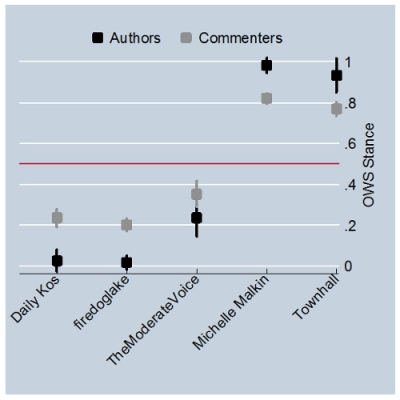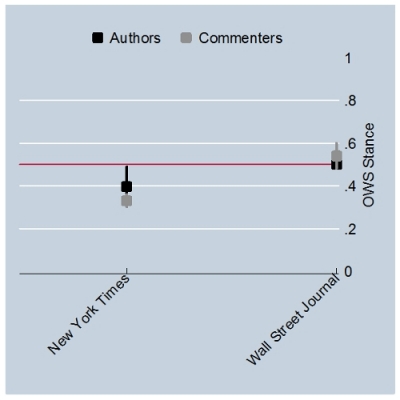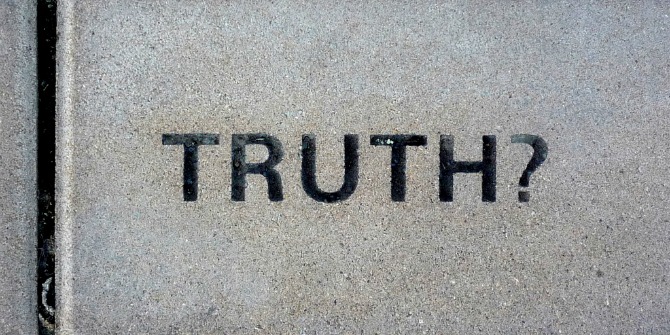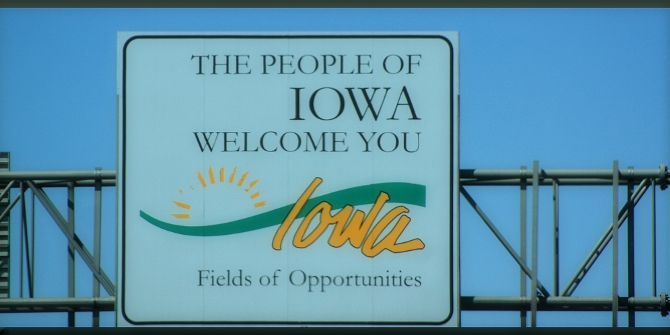 Independently hosted political blogs have been with us for more than a decade, and have become forums for commentary and discussion with a variety of styles and formality. These have more recently been joined by newspaper based blogs such as at The New York Times and The Wall Street Journal. But how does commentary and discussion differ between these two types of blogs? By analyzing over 2,300 blog posts and comments across both types of blog, Elizabeth Suhay and her co-authors find that those who write and comment on traditional political blogs are more likely to express more extreme political opinions, and are also likely to be uncivil in their discussions. Writers and commenters at newspaper-based blogs, on the other hand, tend to be far less polarized politically, and show a greater degree of civility in their discussions.
Independently hosted political blogs have been with us for more than a decade, and have become forums for commentary and discussion with a variety of styles and formality. These have more recently been joined by newspaper based blogs such as at The New York Times and The Wall Street Journal. But how does commentary and discussion differ between these two types of blogs? By analyzing over 2,300 blog posts and comments across both types of blog, Elizabeth Suhay and her co-authors find that those who write and comment on traditional political blogs are more likely to express more extreme political opinions, and are also likely to be uncivil in their discussions. Writers and commenters at newspaper-based blogs, on the other hand, tend to be far less polarized politically, and show a greater degree of civility in their discussions.
Articles and commentaries on the subject of political polarization in the U.S. have been seemingly ubiquitous for some time now. (See The Monkey Cage’s series on polarization for a particularly comprehensive treatment of the subject.) Collectively, we know a lot about polarization, but not everything.
In new research, my co-authors (Allyson Blackwell, Cameron Roche, and Lucien Bruggeman) and I delve into the world of political blogs, those heavily hyper-linked pieces of online political commentary written in a personal, informal style and posted regularly (traditionally in reverse chronological order) to an individual or group blog site. We use content analysis to investigate two aspects of blogs many find problematic—political polarization and incivility.
A quick preview of our findings: We find that a set of popular American blogs associated with the political left and right are remarkably polarized in their opinions (something everyone suspected, yet no published work seemed to have examined systematically until now); we find that those who express more extreme political opinions on blogs appear to be more likely to engage in incivility; and, finally, we find that content on blogs associated with legacy newspapers (in our study, The New York Times and The Wall Street Journal) is remarkably unpolarized and—relative to conventional political blogs—quite civil. Finally, one of our most novel findings is that these patterns appear among blog post authors as well as readers who leave comments in response to those original posts.
A case study of blog posts and comments on Occupy Wall Street
Testing for polarization, and its relationship to incivility, is not as easy as it may sound, which may explain why so few scholars have done so. Here’s what we did:
First, we analyzed over 2,300 blog posts and reader comments on five popular political blogs: Daily Kos and firedoglake on the left; Townhall and MichelleMalkin on the right; and TheModerateVoice in the middle. (Note that “liberal” and “conservative” blogs are much more numerous—and popular—than moderate blogs. We included TheModerateVoice as a useful comparison point.) We then extended our analysis to blogs associated with the United States’ two leading legacy newspapers with left- and right-leaning editorial pages: The New York Times and The Wall Street Journal. We make no claim that our study is representative of all blogs that cover U.S. politics (given the fluidity of the blogosphere, such an enterprise might well be impossible); rather, we simply tried to capture important ideological diversity among the most popular blogs.
Second, we focused our content analysis on coverage of one of the most discussed political events of 2011: the Occupy Wall Street (OWS) movement. We examined blog “conversations” (which consisted of an original blog post and reader comments) that occurred during a ten-week period, beginning on Saturday, September 17, 2011, the day Occupy Wall Street occupied Zuccotti Park, and ending Friday, November 25, a little over a week after protestors were forced by police to end their encampment. Note that, despite the welcoming slogan “we are the 99%,” the movement’s anti-capitalist, egalitarian, and fairly radical democratic values marked it as leftist in orientation. Thus, we expected that blog authors and commenters on conservative-leaning sites would denounce the movement, whereas blog authors and commenters on liberal-leaning sites would support it. Here again, we do not claim to somehow “represent” all issues the blogosphere might comment on; we chose depth over breadth. However, note that our findings dovetail with other studies of polarization in online media and studies of polarized media coverage of the Tea Party protests, suggesting the OWS case is not unusual.
Polarization and incivility: how much, and how related?
For each blog author post and reader comment separately, we measured the expressed Stance toward Occupy Wall Street. Scores of .5 are “neutral” (meaning the person includes only nonevaluative facts in the post or includes an equal number of positive and negative evaluations of OWS); scores between .5 and 1 indicate anti-OWS views (with “1” representing unwavering opposition); scores between .5 and 0 indicate pro-OWS views (with “0” representing unwavering support).
Opinions among blog post authors and commenters on left-leaning and right-leaning blogs were polarized, as expected. However, the extent of polarization was greater than anticipated. The striking polarization pattern is easily seen if displayed visually. Figure 1 displays average support or opposition to OWS for each blog, among authors and commenters separately.
Figure 1 – Support for or opposition to Occupy Wall Street by political blog

Caption for figure: Figure displays means for Stance toward Occupy Wall Street variable and 95% confidence intervals for each blog. The neutral point (.5) is marked with a red line. 0 = complete support for OWS; 1 = complete opposition to OWS.
Authors on the two conservative sites opposed OWS (Michelle Malkin m = .983; Townhall m = .933); authors on the two liberal sites supported OWS (Daily Kos m = .025; firedoglake m = .016). Note how close to the extremes these means are. If we look at the raw data, we see that blog post authors expressed unwavering support (liberal sites) or opposition (conservative sites) over 90% of the time. Comments followed a similar pattern, although they were somewhat less polarized. For those who pay attention to statistical significance: Note that all differences in means between left and right, as well as between left and middle and between right and middle, are significant (at least p < .01).
The next step in our study was to examine the link between polarization and incivility. Scholars have already documented high levels of incivility on political blogs. Most people attribute this tendency to the anonymous and virtual (as opposed to face-to-face) aspects of blogs. While we agree with common wisdom here, we suspect that incivility online also stems from the ideological extremity often found there. Those who hold extreme opinions are likely more motivated than others to insult the opposition.
To test this hypothesis, we examined whether posts and comments containing more extreme ideological views were more likely than others to engage in incivility, i.e., clearly insulting or demeaning another person or group. In three of four tests—two for authors and two for commenters—we found that higher levels of extremity were indeed associated with more incivility (although these findings were admittedly not as strong as our simple polarization results above). Importantly, nearly all of the incivility was directed at “off-site” actors—e.g., OWS protestors, famous politicians, etc. We did not find much “flaming” within comment threads. Rather, people tended to direct their ire at perceived political enemies in the real world.
Finally, recall our interest in newspaper blogs—a more recent hybrid of old and new media. Are blogs associated with left-leaning and right-leaning newspapers as polarized as the conventional political blogosphere? Do they contain similar levels of incivility?
See Figure 2 below. On the OWS support/opposition measure, blog post authors at The Wall Street Journal were perfectly neutral, with means at .5 and no variance. Blog authors at The New York Times leaned toward supporting OWS slightly, although the bias was modest (mean = .4). (Note: the NYT appears to carry more opinion-type blogs than WSJ; however, the NYT website is careful to distinguish “opinion” blogs from more news-oriented blogs.) Comparing the figure below to the earlier figure, it is obvious that blog posts at the newspapers were considerably less biased than their counterparts at conventional political blogs (differences in means all p < .0001). The figure also shows that, while blog comments at the newspapers were slightly more politically biased than author posts, they also were less biased than their commenter counterparts at liberal and conservative political blogs (p < .001).
Figure 2 – Support for or opposition to Occupy Wall Street by newspaper blogs

Caption for figure: Figure displays means for Stance toward Occupy Wall Street variable and 95% confidence intervals for blogs associated with each newspaper. The neutral point (.5) is marked with a red line. 0 = complete support for OWS; 1 = complete opposition to OWS.
Finally, we also compared levels of incivility on the newspaper blogs to incivility on the conventional political blogs. As expected, incivility was lower on the newspaper blogs. Blog post authors at The New York Times and The Wall Street Journal exhibited no incivility at all, whereas 11% of posts by authors on political blogs contained some incivility (difference of proportions p < .10). Also, while approximately 4% of comments on the newspaper blogs were uncivil, 10% of political blog comments were uncivil (difference of proportions p < .001).
Why did the author posts and comments on blogs associated with traditional newspapers exhibit less bias and incivility overall? First, there are strong norms of neutrality and civility at most legacy newspapers, which likely carry over to authors writing on the blog platform. With respect to commenters: the fairly neutral blogs associated with these two major newspapers will certainly draw a less one-sided readership relative to conventional political blogs, and, regardless of who is reading, newspaper blog commenters likely follow more neutral and civil norms set by authors to some extent. In addition, newspapers may be more assiduous than conventional blogs in screening and/or deleting offensive comments. Likely all three factors keep newspaper blog comment sections relatively more neutral and civil than their counterparts at conventional political blogs.
Political blogs are often echo chambers
We add to a growing chorus of scholars who have documented how, within the span of just a few decades, the media landscape in the U.S. has evolved from an emphasis on political neutrality, fact provision, and civility to a place where ideological bias, opinion, and invective are common.
In our view, the popularity of partisan (or, more broadly, ideological) media is problematic for a number of reasons. Studies show that “selective exposure”—consuming media sources that reflect one’s preexisting political biases—among American media consumers is high, particularly so among blog readers. Under these conditions, partisan media polarize audiences. Partisan media influence which issues people think are most important, reinforce partisan views and often make them more extreme, and decrease the likelihood of counterpersuasion (e.g. see here and here). Furthermore, when incivility against political opponents is introduced into partisan media, this has the additional effect of further strengthening ideological views and boundaries, decreasing trust in the opposition and interest in compromise, and spurring copycat incivility.
Conventional political blogs have their place. They are engaging places for like-minded people to build community and even organize political action. But they also tend to be echo chambers, and sometimes nasty ones at that. Unless one is reading a variety of sites representing multiple political perspectives, ideological political blogs will tend to leave the reader with a skewed perspective on current events of political importance. This said, our analysis of a newer class of blogs associated with traditional newspapers indicates that polarization and incivility are not necessary attributes of the blog format. Beyond our study, the recent trend toward online “explainer” journalism (e.g., Vox, The Upshot, Monkey Cage, and USApp!) likewise appears to provide a great deal of insight and to encourage civil interaction among reader-participants. As the Internet continues to evolve, these are productive developments.
This article is based on the paper “Forging Bonds and Burning Bridges: Polarization and Incivility in Blog Discussions about Occupy Wall Street,” forthcoming from American Politics Research. Readers are welcome to contact the author (suhay@american.edu) with comments/questions or for a copy of the article for personal or academic use.
Featured image credit: Thomas Hawk (Flickr, CC-BY-NC-2.0)
Please read our comments policy before commenting.
Note: This article gives the views of the author, and not the position of USApp– American Politics and Policy, nor of the London School of Economics.
Shortened URL for this post: http://bit.ly/1EZG95L
_________________________________
 Elizabeth Suhay – American University
Elizabeth Suhay – American University
Elizabeth Suhay is an Assistant Professor of Government in the School of Public Affairs at American University. She specializes in the study of public opinion and political communication within the American context. Recent publications include “Explaining Group Influence: The Role of Identity and Emotion in Political Conformity and Polarization” (Political Behavior) and “Does Biology Justify Ideology? The Politics of Genetic Attribution” (with Toby Jayaratne, in Public Opinion Quarterly). In spring 2014, The ANNALS of the American Academy of Political and Social Science will publish a special issue (co-edited with James Druckman) called “The Politics of Science: Political Values and the Production, Communication, and Reception of Scientific Knowledge.”






